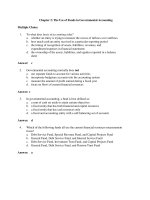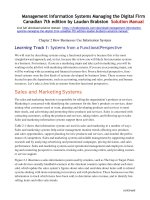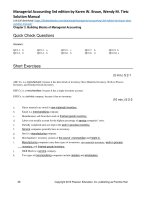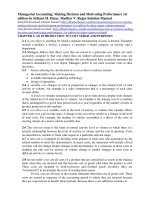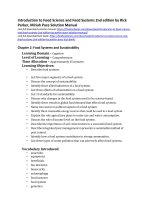Introduction to governmental and notforprofit accounting 7th edition by ives patton solution manual
Bạn đang xem bản rút gọn của tài liệu. Xem và tải ngay bản đầy đủ của tài liệu tại đây (373.41 KB, 11 trang )
Introduction to Governmental and Not-for-Profit Accounting 7th edition
by Martin Ives, Terry K. Patton, Suesan R. Patton Solution Manual
Link full download solution manual: />Link full download test bank: />---------------------------------------------------------CHAPTER 2------------------------------------------------------REVIEW QUESTIONS
Q 2-1 A fund is a fiscal and accounting entity with a self-balancing set of accounts recording cash and
other financial resources, together with all related liabilities and residual equities or balances, and changes
therein, which are segregated for the purpose of carrying on specific activities or attaining certain
objectives in accordance with special regulations, restrictions or limitations.
Q 2-2 The basic purpose of fund accounting is to help ensure compliance with legal restrictions on the use
of governmental resources. Funds are generally established pursuant to law. They serve as a control
mechanism to ensure budgetary compliance and help ensure resources are spent for the specific purposes
intended.
Q 2-3 The three categories of funds are: governmental-type (to account for the basic day-to-day-services
provided by government; proprietary-type (to account for governmental activities that operate in a manner
similar to private sector enterprises in the sense that they charge fees for services); and fiduciary-type (to
account for resources held in a trust or agency capacity for others).
Q 2-4 Measurement focus relates to what is being expressed in the financial statements and which
resources are being measured. The economic resources measurement focus is used in measuring whether
revenues exceeded expenses. It takes account of transactions and events that affect all the resources
available to the activity – financial and capital. Proprietary-type and fiduciary-type funds use the economic
resources measurement focus.
The current financial resources measurement focus is concerned with flows of cash and near-cash
items. It takes account of current financial resources only. Acquisitions of capital assets are reported as
outflows of financial resources, rather than as exchanges of financial resources for capital resources.
Proceeds of long-term debt are reported as inflows of financial resources rather than as long-term liabilities.
Governmental-type funds use the current financial resources measurement focus,
Q 2-5 The governmental budget process is one of estimating the yield from taxes and other sources and
authorizing the expenditure of those resources. Although most state laws require governmental budgets to
be balanced, they do not specify that budgetary balance must be achieved in the accrual accounting sense.
The revenue aspect of the budget focuses on the availability of resources for spending. When budgets
provide authority to spend, the authority relates to current outflows of budgetary resources. Thus, the
budget and budgetary measurements focus on the short run. For example, once resources are used to
acquire capital assets, the resources are no longer available for spending. Governmental accounting systems
have historically provided information to help manage budget execution. As a result, accounting
measurements within the funds have tended to be similar to budgetary measurements.
Q 2-6 Under the full accrual basis of accounting, revenues are recognized in the period in which they are
earned, and expenses are recognized when resources are consumed or liabilities are incurred.
Under the modified accrual basis of accounting, revenues are recognized in the period in which
they are measurable and available, the term “available” meaning that the revenues must be collected either
within the current period or soon enough thereafter to be used to pay the bills of the current period.
Expenditures under modified accrual accounting are generally recognized in the period in which services
and goods are received and a liability is incurred, but there are specific exceptions to this rule so certain
items are not recognized until the liabilities come due for payment.
Governmental-type funds use the modified accrual basis of accounting. Proprietary-type and
fiduciary-type funds use the accrual basis of accounting.
Q 2-7 The governmental-type funds and their purposes are:
General – to account for all financial resources not accounted for in some other fund; or more generally,
the day-to-day general activities of government.
Special Revenue – to account for the proceeds of specific revenue sources that are restricted or
otherwise limited to spending for specified purposes other than debt service and capital projects.
1
Chapter 2
Debt Service – to account for financial resources restricted or otherwise limited to spending for principal
and interest on general long-term debt.
Capital Projects – to account for financial resources restricted or otherwise limited to spending for
capital outlays, including facilities and other capital assets.
Permanent – to account for resources legally restricted so that only earnings from the resources (and
not the principal itself) may be used to support governmental programs.
Q 2-8 The controller is at least partially correct. The general rule in governmental accounting is to use as
few funds as possible in the accounting system. Using fewer funds makes accounting and budgeting more
flexible and less cumbersome. On the other hand, having separate funds does help to demonstrate
accountability for restricted resources, as in the case of bonds approved by the citizens for use only to
construct a specific capital project. Thus, although it is theoretically possible to run city government using
only one fund, that is not likely to occur very often.
Q 2-9 There are no capital assets in governmental-type funds because those funds account only for inflows
and outflows of financial resources. Governmental-type funds can be used and indeed are used to acquire
capital assets. When that happens, however, the accounting within the funds is such that there is an
expenditure of financial resources, rather than an exchange of a financial resource for a capital asset.
Capital assets are reported in government-wide financial statements, but not in fund financial statements.
Q 2-10 The proprietary funds and their uses are as follows:
Enterprise – to account for resources used to supply goods and services, for a fee, to users primarily
external to the government itself, such as the general citizenry.
Internal Service – to account for resources used to supply goods or services, on a cost-reimbursement
basis, within the government unit and other governments. (The government unit is the predominant user.)
Both funds are used to account for activities involved in providing goods or services. The
difference lies in the fact that Enterprise funds sell primarily to nongovernmental users (e.g., citizens who
use a toll road or toll bridge), whereas Internal service funds sell to users within the governmental unit and
to other governments (but the government unit must be the predominant user).
Q 2-11 Enterprise funds and internal service funds use full accrual accounting in order to determine full
cost – that is both operating costs and capital costs. Having full costs enables managers of these entities to
have appropriate data for determining user charges.
Q 2-12 The fiduciary-type funds and their uses are as follows:
Pension Trust – to account for resources held in trust for employee retirement plans and other employee
benefit plans.
Investment Trust – to account for resources of an external investment pool managed by a sponsoring
government.
Private-Purpose Trust – to account for resources of all other trust arrangements maintained by a
governmental unit for the benefit of individuals, other governments, and private organizations.
Agency – to account for resources held in a custodial capacity for some other organization and that must
be disbursed according to law or contractual agreement.
Q 2-13 Agency Funds do not have a fund balance because the governmental unit does not own the assets.
Instead, the governmental unit simply holds resources belonging to others and disburses those resources in
accordance with law or contract.
DISCUSSION SCENARIOS AND ISSUES
D 2-1 The General Fund was used to account for basic day-to-day services, including sanitation. The
suggestion to cover all sanitation costs through a separate user fee requires establishment of an Enterprise
Fund. Enterprise Funds use an economic resources measurement focus and the accrual basis of accounting,
as contrasted with the General Fund’s use of the current financial resources measurement focus and
2
Chapter 2
modified accrual basis of accounting. The changeover will require capitalizing the capital assets and
depreciating them.
D 2-2 The proposal presumably calls for billing each department when they use the central motor pool so
the pool will be able to cover all operating costs. This requires establishing an Internal Service Fund.
Internal Service Funds use the economic resources measurement focus and accrual basis of accounting.
This differs from the current financial resources measurement focus and modified accrual basis of
accounting currently used to account for the vehicles. The vehicles will need to be capitalized and
depreciated.
D 2-3
a.
b.
c.
d.
These are the some of the points that might be covered:
Excessive use of Special Revenue Funds reduces the government’s budgetary flexibility. Doing
away with them may help the government finance higher priority needs without raising taxes.
The issue is worth studying, because some Special Revenue Funds may still have a valid basis and
some may no longer have a valid basis.
Special Revenue Funds are not necessarily related to “special interests” as that term is generally
used.
Special Revenue Funds are often established to finance a particular need (say, parks improvement)
and to dedicate the resources to meeting that need (say, parks admission fees). Therefore, merging
restricted resources with General Fund resources will make it impossible for the restricted
resources to be used for the purposes for which they were raised.
D 2-4 These are some of the points that might be covered.
a. The mayor’s proposal is undoubtedly illegal. Advise the mayor to seek another appropriation if he
wishes to increase the level of police protection.
b. If the mayor persists, advise him to obtain a legal opinion from Cordelia’s corporation counsel,
because the bonds were sold to construct a firehouse.
c. Tell the mayor that citizens and the media will surely wonder what happened to the new firehouse
– and start asking questions.
EXERCISES
E 2-1 (5 minutes)
1. Governmental-type
2. Governmental-type
3. Fiduciary-type
4. Fiduciary-type
5. Proprietary-type
E 2-2 (5 minutes)
1. Capital Projects Fund – Current financial resources (CFR); Modified accrual basis (MA)
2. General Fund – CFR; MA
3. Pension Trust Fund – Economic resources (ER); Accrual basis (A)
4. Agency Fund – ER; A
5. Internal Service Fund – ER; A
E 2-3 (5 minutes)
1.
2.
3.
4.
General Fund
Capital Projects Fund
Debt Service Fund
Pension Trust Funds
3
Chapter 2
E 2-4
(15 minutes)
1. False. Unless legally mandated or financial resources are being accumulated for debt service
coming due in future years, Debt Service Funds are not absolutely required. Capital Projects Funds are not
required to be used if, say, smaller items of equipment are acquired with general tax revenues and paid for
directly from the General Fund.
2. True
3. False. Governments may supplement specific sources of revenue for Special Revenue Funds
with transfers from the General Fund. However, the proceeds of specific sources of revenue should
comprise a substantial portion of the resource inflows to the Special Revenue Fund.
4. False. Capital assets financed by Proprietary Fund resources are accounted for in a Proprietary
Fund, not in a Capital Projects Fund.
5. False. Debt Service Funds are used to accumulate resources for paying debt service coming due
both in the current and future years. In fact, such funds must be used if the government is accumulating
resources for debt service coming due in future years.
E 2-5
(10 minutes)
1. False. The acquisition or construction of capital assets in governmental-type funds is recorded
as an expenditure and is not capitalized and depreciated.
2. True
3. True
4. False. Property tax revenues are recognized to the extent they are measurable and available.
Available means collected in the current period or soon enough thereafter to be used to pay the bills of the
current period, generally 60 days after the accounting period ends.
E2-6
(15 minutes)
1. True
2. False. Enterprise Funds may (and often do) received subsidies from the General Fund.
3. False. Enterprise Funds report expenses. Capital outlays result in assets, which are depreciated.
To ascertain the capital assets acquired during the year, read the statement of cash flows.
4. False. Expenses are accrued if applicable to the current year, regardless of when they ae
expected to be paid.
5. True
E2-7
(10 minutes)
1. False. By definition, Fiduciary Funds are used to account for assets held by a government in a
trust or agency capacity for others (individuals, other governments or private organizations).
2. True
3. True
4. False. Equity securities of a Pension Trust Fund are reported at fair value.
E 2-8
(15 minutes)
Financial statements prepared for Enterprise Funds differ from financial statements prepared for
the General Fund because Enterprise Funds use the economic resources measurement focus and accrual
basis of accounting, whereas the General Fund uses the current financial resources measurement focus and
modified accrual basis of accounting. As a result, Enterprise Fund balance sheets contain capital assets and
long-term liabilities, but the General Fund balance sheet does not. The Enterprise Fund operating statement
reports expenses (including depreciation), but the General Fund operating statement shows capital outlays
and repayment of bond principal as expenditures and bond proceeds as resource inflows. The Enterprise
4
Chapter 2
Fund balance sheet separates current from long-term assets and liabilities, but the General Fund balance
sheet has only current financial resources.
E 2-9
(20 minutes)
Peachum cannot do all he wants to do, but may be able to do part of it, for the following reasons:
a. The fund balances of the Special Revenue and Capital Projects Funds are restricted by law.
b. The $760,000 item in the General Fund, captioned nonspendable, represents long-term loans
and is therefore not accessible for property tax relief unless and until the loans are repaid.
c. $1,896,000 is already assigned to help balance the subsequent year’s budget, and is therefore
not accessible unless budgeted expenditures can be reduced.
d. $1,426,000 may be accessible, provided he can convince the other commissioners that the
needs for which they are assigned are not as important as property tax reduction.
e. The unassigned $3,685,000 is accessible provided the other commissioners agree that there is
no need to maintain a cushion against potential future economic downturns or emergency spending needs.
Reducing the cushion also runs the risk of a downgrade in the entity’s credit rating.
E 2-10 (15 minutes)
1.
General Fund - $605,000; Enterprise Fund - $605,000
(Accruals of the “stub period” salary are made both under the modified accrual and accrual
basis of accounting.)
2.
General Fund - $100,000; Enterprise Fund - $5,000
(General Fund reports the entire capital outlay as expenditures. Enterprise Fund reports only
depreciation for six months as expenses. ($100,000/10 = $10,000; $10,000/2 = $5,000)
3.
General Fund - $13,000; Enterprise Fund - $3,000
(General Fund reports entire debt service payment as expenditures. Enterprise Fund reports
principal repayment as reduction of liability and interest payment as expense.
E 2-11 (5 minutes)
1.
2.
3.
4.
5.
6.
Capital Projects Fund
General Fund
General Fund
Agency Fund
Debt Service Fund
Capital Projects Fund
E 2-12 (10 minutes)
1.
2.
3.
4.
5.
6.
7.
8.
Enterprise Fund, General Fund
Enterprise Fund, General Fund
General Fund
Capital Projects Fund
General Fund
Debt Service Fund
Internal Service Fund, General Fund
Special Revenue Fund
E 2-13 (10 minutes)
1.
2.
3.
Enterprise Fund
Internal Service Fund, General Fund
Investment Trust Fund
5
Chapter 2
4.
5.
Special Revenue Fund
General Fund, Pension Trust Fund
E 2-14 (5 minutes)
One way to reduce the number of governmental-type funds is to combine funds that have a similar
purpose. Another way is to abolish funds that no longer serve a useful purpose. For example, it may be
possible to combine some Special Revenue Funds or to abolish certain Special Revenue Funds and account
for their revenues and expenditures in the General Fund. In doing this, the governmental unit must be
careful not to violate any laws. The mayor may need to obtain legislative approval to abolish certain funds.
E 2-15
(20 minutes)
Because of the nature of this exercise, no specific advance solution can be prepared. These
examples are illustrative of potential solutions.
1. A county would establish an Investment Trust Fund if school districts within the county are
required by state law to invest with the county treasurer all cash not immediately needed to
conduct day-today operations.
2. An Agency Fund would be used if a state collects sales taxes both for itself and all the
counties within the state, with the county shares to be sent to them after the state determines
how much belongs to each county.
3. A Special Revenue Fund would be used to account for parks admissions fees that must be
used for parks maintenance purposes.
4. A Capital Projects Fund would be used to accumulate resources to be spent for constructing a
new police station.
5. An Internal Service Fund would be used to account for the activities of a central purchasing
activity that buys and stores supplies for all city agencies.
6. An Enterprise Fund would be used to account for a municipal electric utility that purchases
and distributes electricity to city residents.
E 2-16 (10 minutes)
1.
2.
3.
4.
5.
6.
7.
EF
DSF
GF
ISF
SRF
GF
EF, ISF
PROBLEMS
P 2-1 (Easy – 20 minutes)
The three fund categories used in governmental accounting are:
Governmental-type funds – These funds are used to account for general governmental activities
(the day-to-day operating activities) and resources that are restricted as to use. The General Fund accounts
for all activities for which no other fund is specified. In effect, it accounts for the day-to-day operating
activities of government. Special Revenue Funds account for resources dedicated by law to a specific
purpose. The other Governmental-type funds are the Capital Projects, Debt Service, and Permanent Funds.
They use the current financial resources measurement focus and the modified accrual basis of accounting.
Proprietary-type funds – These funds are used to account for a government’s business type
activities, involving the sale of services or products that are paid for by user charges. Enterprise Funds are
used to account for activities that provide services or products primarily to the general public. Internal
6
Chapter 2
Service Funds provide for activities that sell services or products within the government. They use the
economic resources measurement focus and the accrual basis of accounting.
Fiduciary-type funds – These funds are used to account for resources held by the government in a
trustee or agency capacity and that therefore cannot be used to support the government’s own programs.
Pension Trust Funds account for pension benefits to government employees. Agency Funds account for
resources held, generally for a short period of time, for others in an agency capacity. Other Fiduciary Funds
are Investment Trust Funds and Private-Purpose Trust Funds. These funds generally use the economic
resources measurement focus and the accrual basis of accounting.
P 2-2
(Moderate – 20 minutes)
The following abbreviations are used in the answer table:
Current financial resources measurement focus
Economic resources measurement focus
Modified accrual basis of accounting
Accrual basis of accounting
Balance sheet
Statement of revenues, expenditures, and changes in
fund balances
Statement of fund net position
Statement of revenues, expenses, and changes in
fund net position
Statement of cash flows
Statement of fiduciary net position
Statement of changes in fiduciary net position
Type of fund
1. General
2. Capital Projects
3. Debt Service
4. Internal Service
5. Enterprise
6. Pension Trust
7. Investment Trust
8. Agency
Measurement
Focus
CFR
CFR
CFR
ER
ER
ER
ER
ER
CFR
ER
MA
A
BS
SRECFB
SFNP
SRECFNP
SCF
SFidNP
SCFNP
Basis of Financial
Accounting
Statements
MA
BS, SRECFB
MA
BS, SRECFB
MA
BS, SRECFB
A
SFNP, SRECFNP, SCF
A
SFNP, SRECFNP, SCF
A
SFidNP, SCFNP
A
SFidNP, SCFNP
A
SFidNP
P 2-3 (Moderate – 25 minutes)
1.
2.
3.
4.
This municipal clinic probably would be set up as an Enterprise Fund because it charges fees
for its services and bills to recover costs for services provided to Medicaid-eligible patients. It
therefore needs to have full cost information (including depreciation on buildings and
equipment) on an accrual basis to help establish the fees and bills for costs of services.
A centralized printing operation should be set up as an Internal Service Fund. This will allow
for the accumulation of full costs on an accrual basis of accounting so that appropriate charges
for services can be made to the departments requiring printing services.
A regional airport could be established as a separate governmental corporation or as a unit of
one of governments. In either event, it would use Enterprise Fund accounting. This will allow
for the accumulation of full costs on the accrual basis of accounting, so that each
government’s share of the net assets and changes in net assets can be computed accurately.
A Special Revenue Fund would be established to accumulate the taxes dedicated to spending
for the purpose of improving the downtown business area. Creating a special fund helps
provide accountability for the resources to ensure they are used for the intended purposes.
7
Chapter 2
P 2-4 (Moderate – 25 minutes)
1.
2.
3.
4.
5.
6.
7.
8.
9.
10.
11.
12.
13.
14.
15.
GF, DSF
SRF
GF
CPF
CPF
CPF
GF
GF
SRF
GF
GF
DSF
CPF
PF
SRF
P 2-5 (Moderate – 25 minutes)
1.
2.
3.
4.
5.
6.
7.
8.
9.
10.
11.
12.
13.
14.
P 2-6
1.
2.
3.
4.
5.
6.
EF
GF, ISF
EF, GF
SRF
GF
EF, GF
DSF
GF, DSF
CPF
ISF, GF
SRF
PF, SRF
EF
PF and SRF or EF
(Moderate – 10 minutes)
GF, PTF
EF, ISF
ISF, GF
CPF, DSF
GF, CPF
SRF, GF
P 2-7 (Moderate – 25 minutes)
1.
2.
3.
4.
5.
GF, PTF (This assumes the General Fund is the only fund that makes contributions to the PTF. It
is possible that other funds also contribute.)
SRF
CPF
GF, DSF
GF
8
Chapter 2
6.
7.
8.
9.
10.
11.
12.
13.
14.
15.
16.
P2-8
ISF, GF, EF
PF (The investment income should be distributed to a Special Revenue Fund, but could go to the
General Fund, if controls ensure the resources are used only for the intended purposes.)
CPF
GF
GF, AF
GF
DSF
EF
ISF
PF (Distribute investment income to Special Revenue Fund, but could go to General Fund if
controls are sufficient to ensure use for the intended purposes.
ITF
(Moderate – 25 minutes)
1.
2.
3.
P2-9
Measurement focus refers to what is being expressed and which resources are being measured
in reporting an organization’s financial operations and position. Basis of accounting refers to
when assets, liabilities, and expenses / expenditures are recognized in the financial statements.
The economic resources measurement focus is used when an entity wants to determine
whether its revenues exceed its expenses. To do this, it takes account of all resources –
financial and capital. The current financial resources measurement focus is used when an
entity wants to determine whether it has sufficient financial resources available to meet its
immediate spending needs. When an entity uses the economic resources measurement focus,
an outlay for capital assets results in acquisition of a capital asset; the cost of these assets is
amortized over their estimated useful lives. When an entity uses the current financial
resources measurement focus, outlays for capital assets are recorded as expenditures because
they result in the consumption of financial resources.
Under the accrual basis of accounting, revenues are recognized when earned and expenses are
recognized when incurred (or consumed), regardless of cash inflows or outflows. Under the
modified accrual basis, revenues are recognized when measurable and available; and
expenditures are generally recognized when goods and services are received and a liability is
incurred, subject, however, to certain exceptions. Under accrual accounting, property tax
revenues are recognized when the taxes are levied, regardless of when they are expected to be
collected in cash. Under modified accrual accounting, property tax revenues are recognized
when levied, subject to being collected within 60 days after the end of the accounting period
for which levied. If not expected to be collected within that period, the revenue is deferred.
(Difficult – 30 minutes)
1.
2.
3.
A municipally-operated water utility is concerned with determining the cost of providing
water services, so that it can bill in order to meet its financial objectives. Its financial
objectives might be, for example, to break even or to raise sufficient revenues to cover its debt
service requirements 1.5 times. It therefore needs to know its total costs, even though the
expenses might not be currently due for payment. The economic resources measurement focus
and accrual basis of accounting best assist the enterprise in meeting these objectives.
The General Fund is concerned with measuring the amount of financial resources currently
available for spending. Depreciation is of no concern in meeting this objective. Using the
current financial resources measurement focus and modified accrual basis of accounting help
meet this financial objective.
Advantages of current financial resources measurement focus / modified accrual basis:
a. Generally tracks the budget, so it helps provide data useful for budget purposes.
b. Revenue recognition is conservative, which helps avoid cash flow problems.
c. Helpful for assessing whether available financial resources are sufficient to pay for
liabilities due to be paid in the short-term.
9
Chapter 2
Disadvantages of current financial resources measurement focus / modified accrual basis:
a. Has the potential for severely understating the costs of operating government for a
particular period, because it does not record expenditures for items affecting the
current period, but which will not be paid until future periods.
b. Does not provide accurate data for assessing whether the government was able to
“match” revenues with the costs of operating the government for a particular period.
c. Requires separate system to keep track of capital assets and long-term liabilities
P 2-10 (Moderate – 20 minutes)
Jasmin City
General Fund
Statement of Revenues, Expenditures, and Changes in Fund Balance
For the Year Ended December 31, 2013
Revenues:
Property taxes
Licenses and permits
State and federal grants
Miscellaneous
Total revenues
Expenditures:
Education
Parks
Public safety
Highways
Total expenditures
Excess of revenues over expenditures
Other financing sources (uses):
Transfers in
Transfers out
Total other financing (uses)
Net change in fund balance
Fund balance, beginning of year
Fund balance, end of year
$7,000,000
1,000,000
2,000,000
180,000
$10,180,000
2,000,000
750,000
4,000,000
900,000
7,650,000
2,530,000
700,000
(1,500,000)
(800,000)
1,730,000
1,500,000
$ 3,230,000
P 2-11 (Moderate – 15 minutes)
1.
2.
3.
4.
5.
6.
7.
8.
b
c
a
c
a
d
d
b
10
Chapter 2
P 2-12 (Moderate – 20 minutes)
1.
2.
3.
4.
5.
6.
7.
8.
9.
10.
b
a
c
d
b
d
a
d
a
b
P 2-13 (Moderate – 15 minutes)
1.
2.
3.
4.
5.
6.
7.
8.
b
c
a
d
c
b
b
b
P2-14 (Moderate – 15 minutes)
Item
(a) Expenditures
Salaries paid in 2012
3,000,000
Salaries accrued
20,000
Utilities, accrued
10,000
Equipment acquired / depreciation 200,000
Principal paid
100,000
Interest paid
40,000
Totals
3,370,000
(b) Expenses
3,000,000
20,000
10,000
20,000
0
40,000
3,090,000
11
Chapter 2
